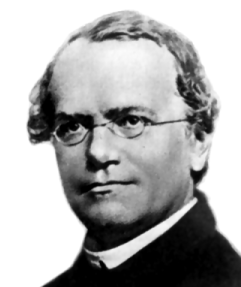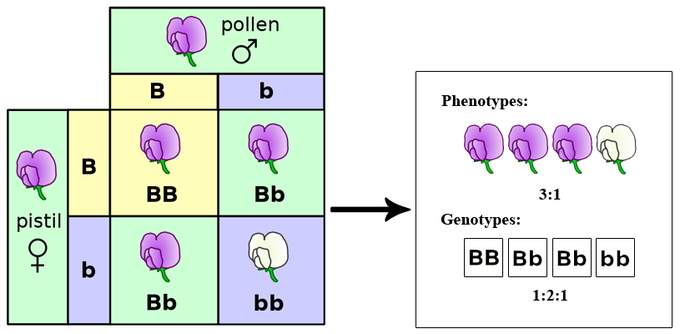12.1A: Introduction to Mendelian Inheritance
- Page ID
- 13256
- Describe the traits of pea plants that were studied by Mendel
Gregor Mendel and the Study of Genetics
Genetics is the study of heredity, or the passing of traits from parents to offspring. Gregor Johann Mendel set the framework for genetics long before chromosomes or genes had been identified, at a time when meiosis was not well understood. For his work, Mendel is often referred to as the “father of modern genetics. ” Mendel selected a simple biological system, garden peas, and conducted methodical, quantitative analyses using large sample sizes.

Mendel entered the Augustinian St. Thomas’s Abbey and began his training as a priest. He began studying heredity using mice, but his bishop did not like one of his friars studying animal sex, so he switched to plants. Mendel grew and studied around 29,000 garden pea plants in a monastery’s garden, where he analyzed seven characteristics of the garden pea plants: flower color (purple or white), seed texture (wrinkled or round), seed color (yellow or green), stem length (long or short), pod color (yellow or green), pod texture (inflated or constricted), and flower position (axial or terminal). Based on the appearance, or phenotypes, of the seven traits, Mendel developed genotypes for those traits.

Because of Mendel’s work, the fundamental principles of heredity were revealed, which are often referred to as Mendel’s Laws of Inheritance. We now know that genes, carried on chromosomes, are the basic functional units of heredity with the capability to be replicated, expressed, or mutated. Today, the postulates put forth by Mendel form the basis of classical, or Mendelian, genetics. Not all genes are transmitted from parents to offspring according to Mendelian genetics, but Mendel’s experiments serve as an excellent starting point for thinking about inheritance.
Mendel made all of his observations and findings crossing individual plants. We can now view a human karyotype of all of the chromosomes in an individual to visualize chromosomal abnormalities in offspring, even before birth. Shortly after Mendel proposed that traits were determined by what are now known as genes, other researchers observed that different traits were often inherited together, and thereby deduced that the genes were physically linked by being located on the same chromosome. Mendel’s work was the beginning of many of the advances in molecular biology over the years.
Key Points
- Mendel studied seven characteristics of the garden pea plants: flower color, seed texture, seed color, stem length, pod color, pod texture, and flower position to develop his Laws of Inheritance.
- Genetics is the study of genes passed from parents to offspring.
- Genes are the basic fundamental units of heredity.
Key Terms
- genetics: The branch of biology that deals with the transmission and variation of inherited characteristics, in particular chromosomes and DNA.


